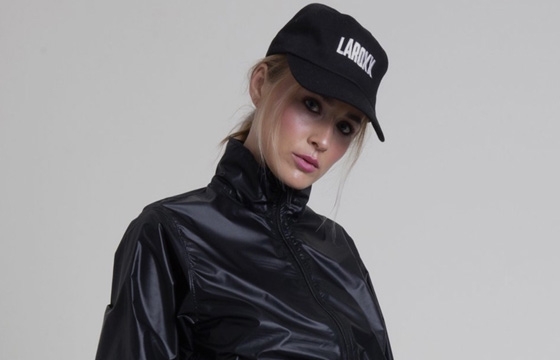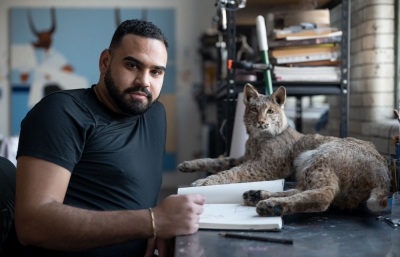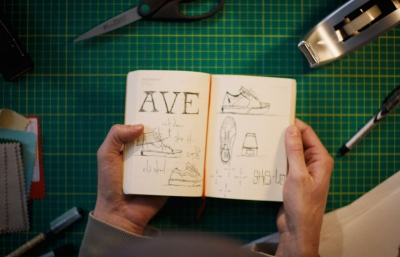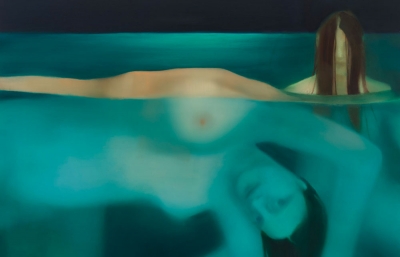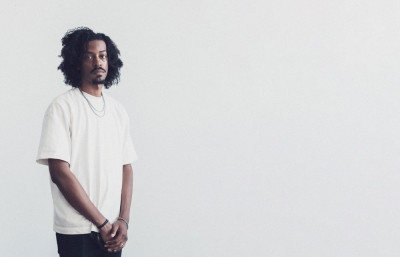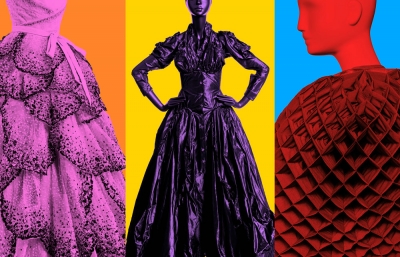With all due respect to Cleveland, and with credit to Aretha, the Freeway of Love does, indeed, lead to Los Angeles. While you're there, throw in bolts of velvet, denim, lace and most definitely, a lot of leather. L.A. Roxx started with the transformative power of leather, so unlike other materials in its ability to evoke adventure, escape and subversion, while it summons touch, smell and even sound. Sharon Rahim enlarged this family venture, and while he still prizes the patina of leather, he's also working with new materials that allow the artist in each of us to express our dreams.
Gwynned Vitello: Can you describe the family dynamics and what that means to you and the company?
Sharon Rahim: Growing up in L.A. as a first generation American, I've had to process my identity. That my father had to escape the Iranian regime, in the late '70s, greatly affected me. He witnessed persecution and saw things I bet he would rather forget. He was a survivor and needed to save his family. I was young and didn't weigh the circumstances until much later, but I can't imagine what that must have been for him. My brothers are a lot older than I. They were my father figures growing up, my mentors. I was around them all the time and tried to emulate them as much as possible. I would wear their clothes and try to be around them. They taught me everything I know, and I owe a lot of my skills to them.

How old were you when you started hanging out at the office, so to speak, and what did you absorb?
It was around 1987/'88 when I first started hanging out at the store. I was about four years old, and my parents were getting a divorce. A couple years prior, my dad came up to my brother and said, “Hey, I paid the rent for the store until the end of the month. It's yours. Do whatever you want with it.” So my brothers started L.A. Roxx and I had to go to the store with them. My mom had to work 'round the clock, my dad was working—there was no one else to watch me! I would mess around with them and the employees. At first, I would have to hang in the back warehouse where I'd walk around, look at all these crazy looking jackets, talking and playing around with the seamstresses, pattern makers and artists. I was a good little boy looking for a little attention, ha ha.
Being a product of divorce, my much older brothers had the opportunity and need to break out and create a successful company. Any chance to be around them, I would take it, after school, summer, weekends, vacations, shadowing them at their meetings in downtown L.A. I pretty much would come in and be useful, however I could be, including cleaning the shop and studio.
As the company expanded, I was around salespeople who emulated the rock stars of the time, betting on how many jackets they could sell that day and how many girls they could pick up. I was around designers and artists who were airbrushing and studding leather jackets. Witnessing what my brothers were tapping into was special, shooting a jacket with shotguns, bleaching jackets, or stone-washing them just to make a different look. Everything was one of a kind, so artists would feel they could wear it on stage. They designed shop windows that were shocking in a pre-internet time. People would pull over while driving by just to look inside.
Was it always L.A. Roxx, and though it seems obvious and natural, how did the name come about?
My brother Sean tells me that when they first opened the shop, he would see a lot of guys walking around Hollywood Boulevard with long hair, tight jeans and biker jackets. They would come in asking for short cropped motorcycle jackets, and as they started bringing in rocker inspired clothing, they wanted a name that embodied rock culture, L.A. and the sex, and so, the double XX.

So it pretty much started with leather. Tell me what you think is so special about its qualities, and also the constraints. How do you source it?
Starting with those cropped motorcycle jackets, my brothers initially repurposed leather they had sourced locally in downtown from a family friend by altering, deconstructing and adding things. They took spray paint, stenciled a skull design, sprayed the back of the jacket and put it in the window display. It immediately sold and they realized they had something cool, so started expanding on it to tight jeans, to lace-up leather pants, all made more special by customization. Everything was one of a kind, and nobody had anything like it. No one had put tattoo-inspired art or airbrushing on a leather jacket. Then they started adding bootstraps and customizing belts with studs or laces and adding them to the jackets. The crazier it was, the more people liked it. When they started making their own pieces, they would source leathers locally, but also from all over. This local Persian leather dealer would bring in material from Italy, Argentina and Pakistan. Currently, we work with artists and musicians who require the ability to move and dance, so I look for softer, thinner leathers that have some stretch.
Leather signifies my history. The smell brings me back to my childhood, a time when things were simpler. When I think of it now, it represents something substantial in its durability, its quality. Creating a piece is a lot different than sewing a garment. You have to pattern and sew it differently. I feel like it has so much more value, and I take that seriously.
What are other fabrics or materials that kind of represent the brand, and what do you like about them?
I've expanded so much from just leather. I love experimenting and always want to make things that look unique. I remember being made fun of when I was growing up because I didn't want to dress like everyone else, and that mindset plays into what L.A. Roxx is today. We play with plastics and vinyl because it fucking looks and feels so future; nylon because it's comfortable but can be dressed up; denim and cotton because of the utilitarian and sustainability qualities, and organza and mesh because it's light, sexy and makes a great layering piece.

I love looking at the sketches for your designs. Does every piece start out that way, and do you sketch them? Does it always start with the individual piece, or do you sometimes do a whole look first?
Most of the time, we start with a sketch, and whether it's a piece or full look depends on the client. I prefer whole looks, but even those start with a piece. I usually visualize what I want it to look like and translate it the best I can to them team. But it's also necessary that the client also be able to visualize it, as well, which gets them excited. But being a custom house and working on some unreal deadlines at times, sometimes we wing it. I guess I like to go off-script a little too much, but I think some of our best work comes out that way.
Since so much of the work is custom, I'd like to hear about the process. The person who wears it is as much of the experience as the designer. What is one of the most personal pieces you have designed as a result of your own vision?
Being a custom house, a lot of my job is bringing other people's concepts to life. Of course, I always put my touch in the piece or look. We currently have a lot of pieces that are a result of my own vision at our showroom that a lot of our clients end up buying if they can't do custom. My ultimate goal is my namesake line, Sharon Rahim, which is currently in progress. That'll consist of my personal likes such as military, Goth, camp, and a utilitarian aspect, which will all be housed at the showroom this fall. L.A. Roxx started as a store and transitioned into a showroom. For me, I always regarded it as a platform to introduce new culture into fashion. It's a springboard for ideas and like-minded creatives to express themselves.

Can you describe your design studio, maybe how you have it set up to feel comfortable, create the right mood?
Currently a mess and in need of more space. We're in the process of moving to a bigger space, something like five times bigger than what it currently is. I haven't had a chance to think about what it will look like. But I can tell you it'll look rad. We're also gonna be using the L.A. Roxx brand as not only a place for our custom work, but a space where we can pick and choose a few super select brands to house. I'm really excited about that.
L.A. Roxx, by definition, evokes California. But tell me about other influences, any elements you draw from other designers?
Frankly, L.A. Roxx evokes Los Angeles more than California. Downtown houses a tight-knit community. On any given morning, we share tea, talk shop, talk sourcing and materials. To me, L.A. is the place where all the influence derives. People are moving here at a rapid rate, and everyone wants a piece of the pie. Like I said, my influences were initially rock 'n' roll because that's just what I know, and then the hip-hop influence of the '90s and 2000s. I personally am drawn to designers like Raf Simons and Comme des Garçons, but if I'm being really honest, I don't look at other designers for influence. I might have, at the beginning, when I was starting out, when I was trying to figure out my style, but not anymore. I just look at what I want to push, and move towards that.
You have said that you want to change the world with your clothes, and it's always interesting to hear designers explain why fashion is their passion.
Fashion is the only thing I really know how to do. Thinking of how I process the influence of my dad, my family, it does affect the way I approach design. In some way, you could say that what I do is create clothing that provides escapism. We work in the music space where musicians, after all, create their art to help us cope. I suppose I play a small role in it, as well. There is no option or Plan B for me. This is it. And if I'm gonna do it, I'm gonna make sure I influence the narrative.

